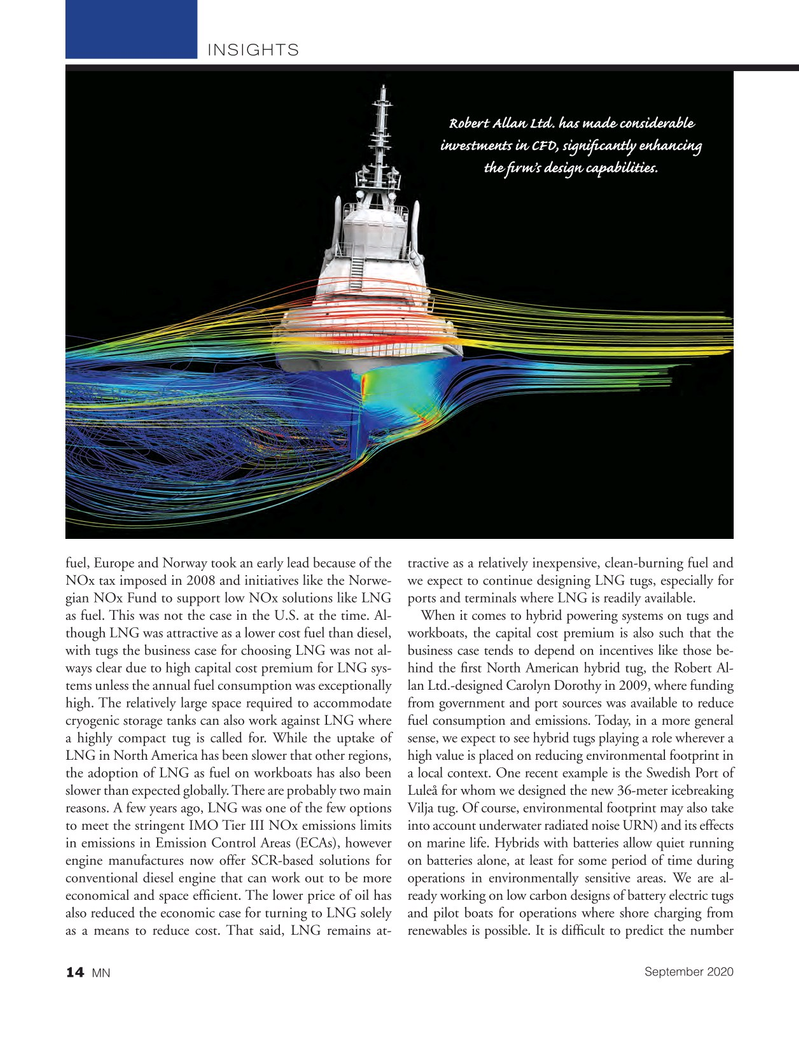
Page 14: of Marine News Magazine (September 2020)
Offshore Annual
Read this page in Pdf, Flash or Html5 edition of September 2020 Marine News Magazine
INSIGHTS
Robert Allan Ltd. has made considerable investments in CFD, signi? cantly enhancing the ? rm’s design capabilities. fuel, Europe and Norway took an early lead because of the tractive as a relatively inexpensive, clean-burning fuel and
NOx tax imposed in 2008 and initiatives like the Norwe- we expect to continue designing LNG tugs, especially for gian NOx Fund to support low NOx solutions like LNG ports and terminals where LNG is readily available. as fuel. This was not the case in the U.S. at the time. Al- When it comes to hybrid powering systems on tugs and though LNG was attractive as a lower cost fuel than diesel, workboats, the capital cost premium is also such that the with tugs the business case for choosing LNG was not al- business case tends to depend on incentives like those be- ways clear due to high capital cost premium for LNG sys- hind the ? rst North American hybrid tug, the Robert Al- tems unless the annual fuel consumption was exceptionally lan Ltd.-designed Carolyn Dorothy in 2009, where funding high. The relatively large space required to accommodate from government and port sources was available to reduce cryogenic storage tanks can also work against LNG where fuel consumption and emissions. Today, in a more general a highly compact tug is called for. While the uptake of sense, we expect to see hybrid tugs playing a role wherever a
LNG in North America has been slower that other regions, high value is placed on reducing environmental footprint in the adoption of LNG as fuel on workboats has also been a local context. One recent example is the Swedish Port of slower than expected globally. There are probably two main Luleå for whom we designed the new 36-meter icebreaking reasons. A few years ago, LNG was one of the few options Vilja tug. Of course, environmental footprint may also take to meet the stringent IMO Tier III NOx emissions limits into account underwater radiated noise URN) and its effects in emissions in Emission Control Areas (ECAs), however on marine life. Hybrids with batteries allow quiet running engine manufactures now offer SCR-based solutions for on batteries alone, at least for some period of time during conventional diesel engine that can work out to be more operations in environmentally sensitive areas. We are al- economical and space ef? cient. The lower price of oil has ready working on low carbon designs of battery electric tugs also reduced the economic case for turning to LNG solely and pilot boats for operations where shore charging from as a means to reduce cost. That said, LNG remains at- renewables is possible. It is dif? cult to predict the number
September 2020 14 MN

 13
13

 15
15
